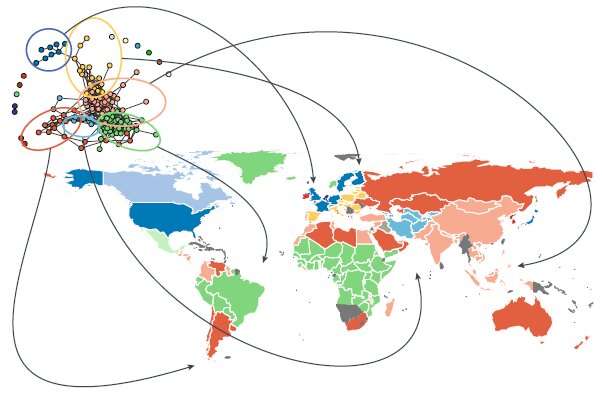Common frame for analyzing complex systems in physics and economics

Scientists often need to make sense of complex systems without knowing the important parameters or even without access to all the information. A collaboration of network theorists has reported a common frame for addressing these problems using only one tool.
Economists attempt to predict financial crises and physicists want to understand systems containing many particles. However, both problems are notoriously challenging. Oftentimes, researchers need to make sense of a system without full information. And even if they have all the information, complex systems are still difficult to grasp because of the many links between components. A wide range of scientific disciplines encounters these issues.
Scientists in the research area of network theory are working on tools for problems such as network reconstruction and pattern detection. However, most of those tools work on only one problem. Now, a collaboration of network theorists from the IMT School for Advanced Study in Lucca (Italy), Leiden University and the Italian Research Council (CNR) has published a review article in the inaugural issue of the new journal Nature Reviews Physics that gives a common frame for addressing multiple problems with one tool.
Network reconstruction
Together with his co-authors, Diego Garlaschelli (IMT Lucca/Leiden) developed methods to reconstruct networks without access to all the information. This is relevant, for example, in the financial world, where banks are only obliged to disclose their total debit and credit. They don't give information on who they lend to and borrow from.
This lack of knowledge often implies a "hidden riskiness." If bank A has lent money to bank B, which in turn has lent money to an unstable bank C, then bank A becomes unstable, as well. When central banks tested several tools on reconstructing a banking system, the one proposed by Garlaschelli and co-authors turned out to be the most successful one. Other independent tests provided the same result.
Pattern detection
The team also works on pattern detection. In that case, researchers do have full information about a complex system and try to find structure. They face two major problems: It is unknown what the important properties are, and there are many parameters. The first problem is solved by creating a randomized system that retains some real-world feature and comparing it to real life.
Garlaschelli says, "We create, for example, a financial system with randomized links between banks under the condition that each bank retains the same number of links it has in the real world, and compare it to the Dutch banking system. From this comparison, we identify the system's important properties and even find early warning signals for the 2008 crisis." The second problem is solved by analytically deducing equations for the probabilities of pairs of nodes being connected. This takes away the need to numerically process a large amount of parameters.
Common frame
The review article in Nature Reviews Physics provides a common frame in which one tool can be applied to both network reconstruction and pattern detection, and even to fundamental aspects of statistical physics. Garlaschelli says, "We have, for instance, found that in some cases, networks behave as an intermediate between Fermi-Dirac systems, where particles cannot be in the same state, and Bose-Einstein systems, where no such restriction is in place. More recently, we have identified a new mechanism responsible for the breaking of a century-old assumption in statistical physics—namely, the equivalence of canonical and microcanonical ensembles, which are traditionally used to describe systems under respectively soft and hard constraints."
More information: G Cimini, T Squartini, F Saracco, D Garlaschelli, A Gabrielli, G Caldarelli (2019), The statistical physics of real-world networks, Nature Reviews Physics, 1, 58-71 www.nature.com/articles/s42254-018-0002-6
Notes:
[1] T Squartini, G Caldarelli, G Cimini, A Gabrielli, D Garlaschelli (2018) Reconstruction methods for networks: the case of economic and financial systems. Physics Reports 757: 1-47.
[2] K Anand et al (2018) The missing links: A global study on uncovering financial network structures from partial data. Journal of Financial Stability 35, 107-119.
[3] P Mazzarisi, F Lillo (2017) Methods for reconstructing interbank networks from limited information: a comparison. In Econophysics and Sociophysics: Recent Progress and Future Directions (pp. 201-215). Springer, Cham.
[4] A Ramadiah, F Caccioli, D Fricke (2018) Reconstructing and Stress Testing Credit Networks. Available at SSRN: ssrn.com/abstract=3084543 or http://dx.doi.org/10.2139/ssrn.3084543
[5] T Squartini, D Garlaschelli (2017) Maximum-Entropy Networks: pattern detection, network reconstruction, and graph combinatorics. Springer International Publishing, isbn:978-3-319-69436-8.
Provided by Leiden Institute of Physics


















